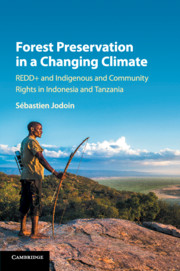 Forest Preservation in a Changing Climate
Forest Preservation in a Changing Climate Book contents
- Forest Preservation in a Changing Climate
- Forest Preservation in a Changing Climate
- Copyright page
- Contents
- Acknowledgments
- Disclosures
- Abbreviations and Acronyms
- Introduction
- 1 The Transnational Legal Process for REDD+
- 2 Rights and REDD+ in International and Transnational Law
- 3 Rights and Jurisdictional REDD+ in Indonesia
- 4 Rights and Jurisdictional REDD+ in Tanzania
- 5 Rights and Project-Based REDD+ in Indonesia and Tanzania
- 6 Comparing Rights and REDD+ in Indonesia and Tanzania
- Conclusion
- Annex I Overview of REDD+ Activities in the Developing World
- Bibliography
- Index
- References
Bibliography
Published online by Cambridge University Press: 21 September 2017
- Forest Preservation in a Changing Climate
- Forest Preservation in a Changing Climate
- Copyright page
- Contents
- Acknowledgments
- Disclosures
- Abbreviations and Acronyms
- Introduction
- 1 The Transnational Legal Process for REDD+
- 2 Rights and REDD+ in International and Transnational Law
- 3 Rights and Jurisdictional REDD+ in Indonesia
- 4 Rights and Jurisdictional REDD+ in Tanzania
- 5 Rights and Project-Based REDD+ in Indonesia and Tanzania
- 6 Comparing Rights and REDD+ in Indonesia and Tanzania
- Conclusion
- Annex I Overview of REDD+ Activities in the Developing World
- Bibliography
- Index
- References
- Type
- Chapter
- Information
- Forest Preservation in a Changing ClimateREDD+ and Indigenous and Community Rights in Indonesia and Tanzania, pp. 215 - 248Publisher: Cambridge University PressPrint publication year: 2017
- Creative Commons
- This content is Open Access and distributed under the terms of the Creative Commons Attribution licence CC-BY-NC-ND 4.0 https://creativecommons.org/cclicenses/


